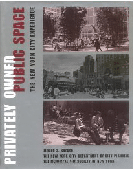
55 Broadway
Three of the four public spaces at 55 Broadway were mandated by the recently repealed Special Greenwich Street Development District, a special purpose zoning district enacted in 1971 to implement an ambitious plan for pedestrian improvements within a 24-block area of lower Manhattan bounded by Broadway to the east, the World Trade Center complex to the north, Battery Park City to the west, and Battery Park to the south. Unlike traditional zoning districts that declare general rules applying uniformly to all lots within the district, the Special Greenwich Street district mapped specific, unique, mandatory and elective pedestrian circulation and lot improvements block-by-block, requiring or encouraging future developments on such blocks to provide such features. The final result was to be an innovative, multi-level pedestrian circulation system facilitating movement, shopping, subway access, and enjoyment of open space in the face of an increasingly dense downtown.

The greatest danger to this type of zoning is that the real estate market will not cooperate, that development will not occur as expected, and that the plan thus will be implemented in a piecemeal fashion that fails to accomplish its overall goals. Such was the fate of the Special Greenwich Street Development District zoning plan. For the lot now occupied by 55 Broadway, for example, the Special Greenwich Street plan required an “enclosed pedestrian bridge” spanning Trinity Place east-to-west, an “elevated shopping way” some 22 feet above and parallel to Trinity Place, a “pedestrian connection” from that “elevated shopping way” to Broadway paralleling Exchange Alley, and an “arcade” along Broadway. When private development on the other side of Trinity Place did not occur as anticipated, the zoning requirement for the “enclosed pedestrian bridge” was dropped before the bridge was ever constructed.
The four legal types of public space that do exist at 55 Broadway were provided to some degree on the assumption that an upper-level pedestrian network would be constructed. Together, the four spaces forge a pathway between Broadway and Trinity Place that duplicates the downward-sloping Exchange Alley immediately adjacent to the north. Beginning next to the intersection of Broadway and Exchange Alley, the narrow urban plaza squeezes pedestrians between the steps leading from the Alley and the arcade under the piano-shaped building edge to the south. Further west, four round tree-filled planters on one side and banded arcade columns on the other flank a chutelike corridor of increasingly narrow width. The covered loggia supplies escalators to navigate the substantial grade change down to the lower-level retail shopping arcade, beyond which is Trinity Place. Without the enclosed pedestrian bridge, however, the loggia now would have no reason to connect pedestrians to an upper-level “elevated shopping way” directly above the existing lower-level shopping arcade along Trinity Place that were together known as a “shopping way” and had been required by the Special Greenwich Street Development District zoning. Thus, like the bridge, the elevated shopping way component of the shopping way was dropped by the City in 1992. That effectively ended the hopes for an upper-level network that would also connect to 45 Broadway’s similarly mapped, but similarly never implemented, elevated shopping way along Trinity Place to the south.
By comparison, another Special Greenwich Street Development District pedestrian improvement amenity suffered an unhappier fate. A mandatory “open pedestrian bridge” spanning Greenwich Street between One Bankers Trust Plaza and a City-owned low-rise building was actually constructed. Unfortunately, contrary to expectations, the existing low-rise building that housed a City fire station and a fast food restaurant was never replaced by the anticipated new office tower that would justify the bridge. After years of carrying no meaningful foot traffic, the bridge was recently demolished.
Even without the upper-level network, three reasons explain why a pedestrian might choose the 55 Broadway pathway over the adjacent Exchange Alley. First, much of it is covered. Second, it is level for much of its run, and allows escalators rather than the slope of Exchange Alley to facilitate the descent or ascent. Third, planter ledges and a movable seating unit that was missing at a recent site visit furnish seating for the momentary stops that pedestrians like to make. A recent site visit also revealed café tables and chairs arrayed in the shopping arcade along Trinity Place. No record of City approval for this use has been found.


